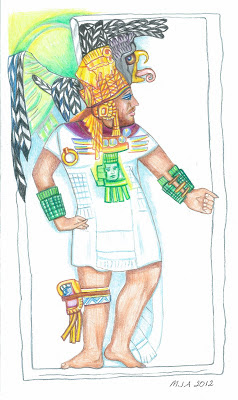Thursday, October 11, 2012
The Dancing King of Dos Pilas in Color
The carved stela with overlaid drawing.
Dos Pilas is a late classic Mayan city located at the headwaters of the Usumacinta River in Guatemala on the border with Mexico.
It is upriver from the major city of Yaxchilan on this main highland waterway that runs into the Gulf of Mexico to the east. What we
know of Dos Pilas has been discovered in the ruin of its destruction. At the end, its last defense was a barrier constructed of the stone
blocks from its decorative roofcombs. The stela carving of the dancing king has obviously been broken and not by an earthquake given the
destruction of war all around it. It is apparent from the break that this monument was carved from a comparitively thin slab of rock. Much
gratitude is due the team of archaeologists who took the time to reassemble this unique carving.
The chieftans of the Maya participated in the ballgame that symbolized the co-existence of the Underworld and its dieties with the terrestrial plane.
They played the game for high stakes as did the participants in their book of creation "The Popul Vuh". The ballcourts were dug low to represent the
lower world. If the hosting team were victorious, the king would perform a victory dance much like the football players of today dance when they`ve
made a touchdown. The profile portrait of the dancing king of dos Pilas portrays just such an event.
The action on this stela has been captured by a talented an innovative artist. It stands in sharp contrast to the stiff poses and static archaic style of the
majority of other Mayan monuments even those other monuments of Dos Pilas itself. The motion in this piece indicates that it is from the late stage of
the civilization.
The headdress of the king is made of the feathers of the Harpy eagle with its distinctive large eyes, raised comb of feathers, and screaming eagle pose.
most Mayan royalty wore green quetzal plumes, but this ruler is adorned with the black and white striped wing feathers of the Harpy. The Aztecs painted the
Harpy as a black and white striped eagle in their codices
The Dancing King of Dos Pilas in color.
The king wears a headress made of the striped feathers of the Harpy eagle which
swoops down to capture monkeys right out of the trees of the towering jungle forest. On his chest, he wears a winged pectoral.
He has a necklace made of blue jade as well as a face carved of precious green jade below his chest pectoral. The colors
of green and yellow used here represent the corn god in whose honor many of the sacrifices were conducted. It is apparent
that this warrior king is a ballplayer from the fringed masked knee pad that he wears on his right knee. The ballplayers knelt
down on one knee in order to hit the large rubber ball with their hip to send it through a stone hoop set high on the ballcourt
wall. Unfortunately, the losers of the ballgame were dispatched to the Underworld as offerings to the gods of Xibalba. The
padded costumes of the warriors on the court were incredibly ornate and individualistic, there was no team uniform. They wore
full headresses adorned with gold, plumes, and gems as they portrayed the gods of the "Popul Vuh" their book of creation.
Judging from the profile of the king, he was from a different tribe than those depicted in the art of the other Mayan cities in the
Peten such as Palenque. The rulers of Palenque bound their heads and had long deformed skulls as well as pronounced Roman
noses. In the later stage of the civilization in this area, the Maya had merged with the tribal types from the Yucatan - the Toltec
Maya, and the inhabitants of the great city of Teotihuacan. Our dancing king`s profile more closely resembles that of the bearded Toltec race that had joined with the civilization of the Usumacinta River basin and highlands. These overgrown jungle cities lay buried and unknown until the 19th century when they were discovered by the workers of the rubber tree sap harvesting industry. Archaeologists found one of the tall carved monuments overturned and reburied upside-down, it had remained in that position undisturbed for hundreds of years. These cities were destroyed at the same time. Fortification walls had been erected between the hills to keep out the invaders, but they were overrun from the south. Perhaps the El Nino storms had devasted the war-like tribes in South America who then came north to invade Mesoamerica. The motion shown in the carving of the smashed and reconstructed stela of the dancing king of Dos Pilas shows that it was carved in the late phase of the city. Much is made of the Mayan prophecies concerning 2012 and the Apocalypse, but we can see from the destruction suffered by this artifact that the apocalypse hit the city of Dos Pilas centuries ago.
Subscribe to:
Post Comments (Atom)


No comments:
Post a Comment